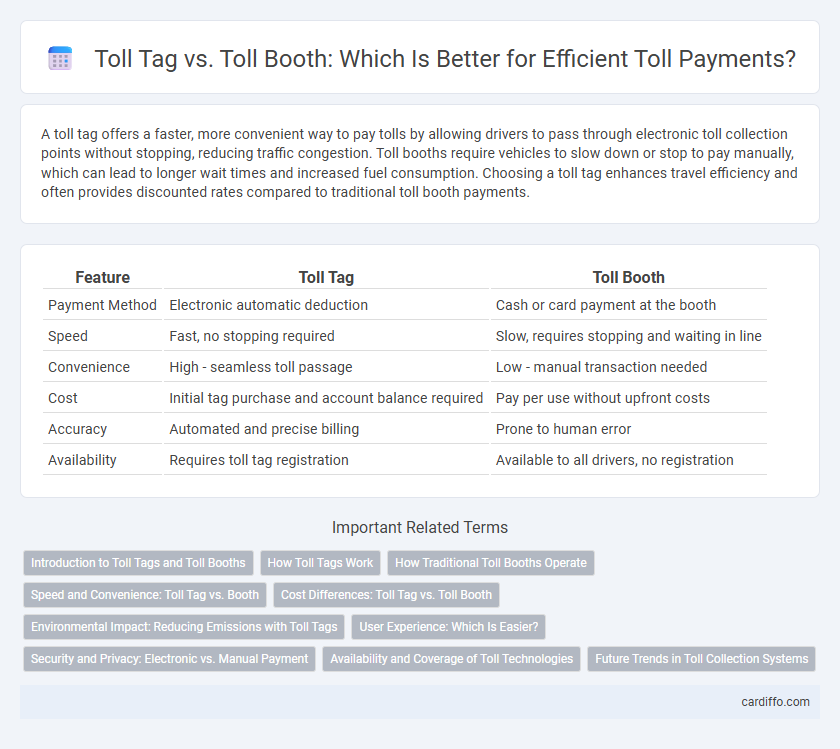A toll tag offers a faster, more convenient way to pay tolls by allowing drivers to pass through electronic toll collection points without stopping, reducing traffic congestion. Toll booths require vehicles to slow down or stop to pay manually, which can lead to longer wait times and increased fuel consumption. Choosing a toll tag enhances travel efficiency and often provides discounted rates compared to traditional toll booth payments.
Table of Comparison
| Feature | Toll Tag | Toll Booth |
|---|---|---|
| Payment Method | Electronic automatic deduction | Cash or card payment at the booth |
| Speed | Fast, no stopping required | Slow, requires stopping and waiting in line |
| Convenience | High - seamless toll passage | Low - manual transaction needed |
| Cost | Initial tag purchase and account balance required | Pay per use without upfront costs |
| Accuracy | Automated and precise billing | Prone to human error |
| Availability | Requires toll tag registration | Available to all drivers, no registration |
Introduction to Toll Tags and Toll Booths
Toll tags are electronic devices that enable automatic payment when passing through toll roads, offering faster and more convenient travel compared to traditional toll booths. Toll booths require drivers to stop and pay cash or use cards, often causing delays and congestion. Implementing toll tags reduces traffic build-up and enhances efficiency on busy highways.
How Toll Tags Work
Toll tags use RFID technology to communicate with toll booths electronically, allowing vehicles to pass through without stopping. The system automatically deducts the toll fee from a prepaid account linked to the tag, enabling faster and more efficient traffic flow. Unlike traditional toll booths requiring cash payments, toll tags reduce congestion and improve convenience for drivers.
How Traditional Toll Booths Operate
Traditional toll booths operate by requiring drivers to stop and pay a fee manually, either through cash or card payments, which often causes traffic congestion and delays. Each vehicle must come to a halt at the booth, where an attendant collects the toll or an automated machine processes the transaction, creating bottlenecks during peak hours. This system differs significantly from electronic toll collection methods like toll tags, which allow seamless, contactless payments without stopping.
Speed and Convenience: Toll Tag vs. Booth
Toll tags offer faster and more convenient passage compared to toll booths by enabling automatic electronic payment without stopping, significantly reducing travel time and congestion. Drivers using toll tags avoid long queues and manual cash transactions typically required at toll booths, enhancing overall traffic flow and minimizing delays. Many modern highway systems prioritize toll tag usage due to its efficiency and seamless integration with digital payment platforms, improving user experience and operational efficiency.
Cost Differences: Toll Tag vs. Toll Booth
Toll tags offer significant cost savings compared to toll booths by providing discounted rates for electronic toll collection, which are often lower than cash payments at booths. Toll booth users typically face higher charges due to manual processing fees and lack of discounts associated with electronic toll programs. Frequent travelers benefit the most from toll tags, as cumulative toll expenses can be substantially reduced through prepaid accounts and reduced transaction costs.
Environmental Impact: Reducing Emissions with Toll Tags
Toll tags significantly reduce environmental impact by enabling vehicles to pass through toll points without stopping, which minimizes idling and associated emissions. Compared to traditional toll booths, electronic toll collection systems lower greenhouse gas emissions by maintaining steady traffic flow and reducing congestion. Widespread adoption of toll tags can contribute to cleaner air and support sustainable transportation initiatives.
User Experience: Which Is Easier?
Using a Toll tag offers a smoother user experience by enabling seamless, contactless toll payments without stopping, reducing traffic congestion and wait times. Toll booths require drivers to slow down or stop to pay manually or interact with an automated machine, often leading to longer delays and frustration. The convenience and speed of Toll tags make them easier and more efficient for users compared to traditional toll booths.
Security and Privacy: Electronic vs. Manual Payment
Electronic Toll Tags employ encrypted data transmission and automated vehicle recognition, significantly reducing the risk of human error and unauthorized access, thereby enhancing both security and privacy. Manual Toll Booth payments require direct human interaction, increasing vulnerability to data breaches and misuse, as cash or card details are handled in person. The digital nature of Toll Tags offers controlled access to toll data, while manual systems often lack stringent privacy measures.
Availability and Coverage of Toll Technologies
Toll tags provide widespread availability across numerous highways and bridges, enabling seamless electronic toll collection without stopping. Toll booths, although prevalent in many regions, have limited coverage and often require manual payment, leading to congestion during peak hours. The increasing adoption of RFID and automatic number plate recognition technologies in toll tags enhances coverage and accessibility compared to traditional toll booths.
Future Trends in Toll Collection Systems
Future trends in toll collection systems emphasize the widespread adoption of electronic toll tags, transforming traditional toll booths into cashless, automated checkpoints. Toll tags enable seamless vehicle identification and real-time billing through RFID and GPS technologies, reducing congestion and enhancing traffic flow. Innovations such as mobile app integration and dynamic pricing models further optimize revenue collection and user convenience.
Toll tag vs Toll booth Infographic

 cardiffo.com
cardiffo.com